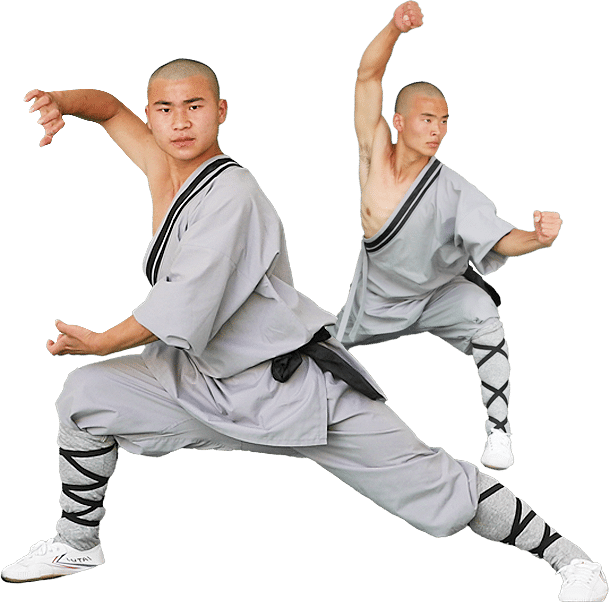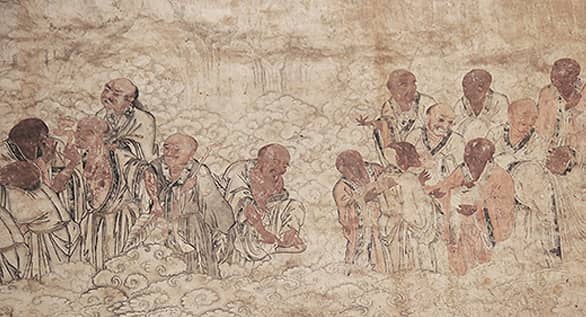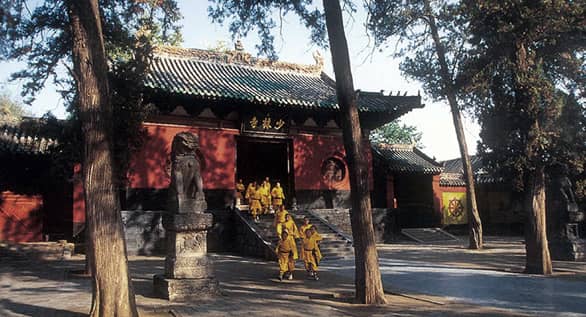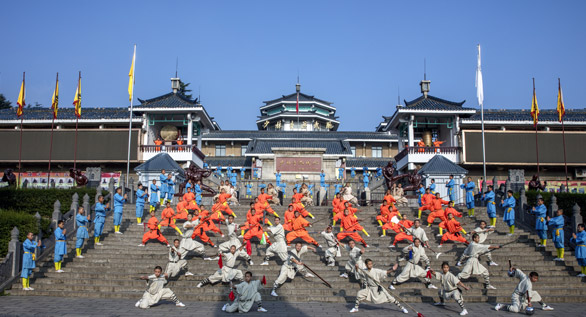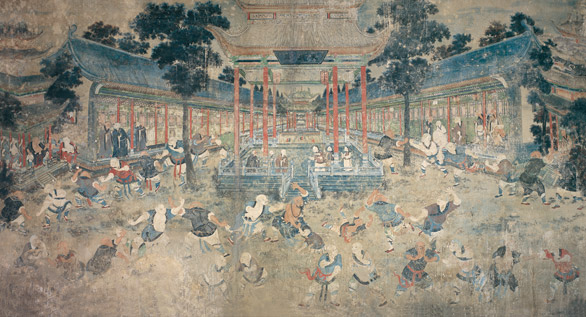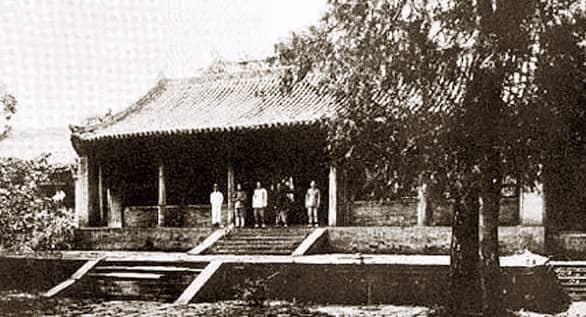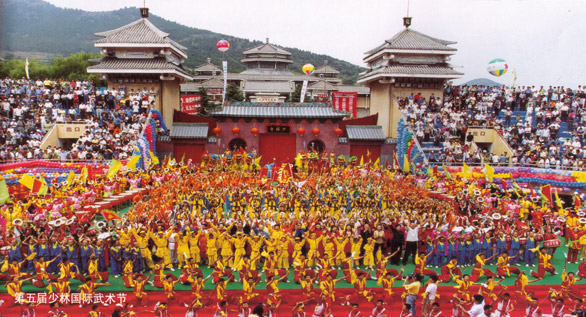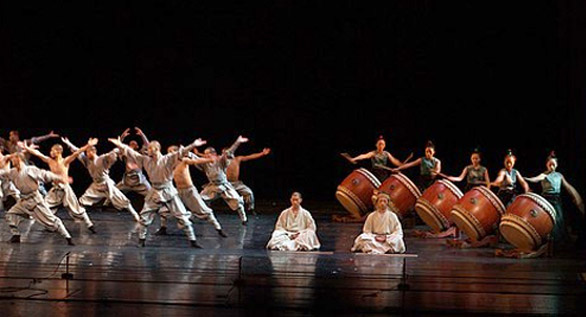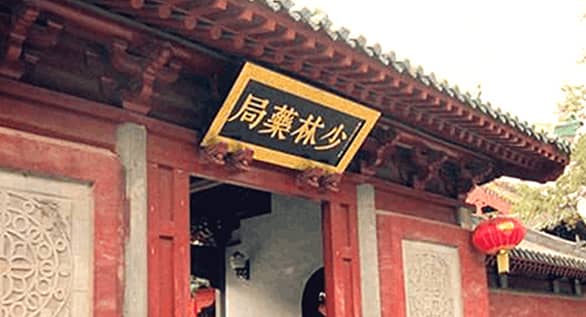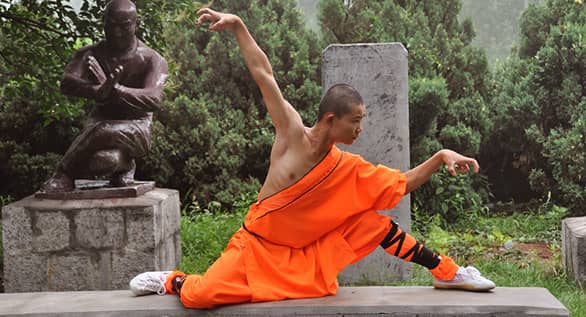Dharma
Dharma, known as Bodhidharma, was a native of the Southern Sindhu, a Brahmin caste, and is said to be the 28th ancestor of Buddhist Chan Buddhism, who sailed to Guangzhou during the Liang Dynasty (502-557 AD). Since Emperor Liangwu believed in Buddhism, Dharma went to meet with Emperor Liangwu in Jianye, the capital city of the Liang Dynasty. Unfortunately, they were at odds with each other, therefore, Dharma crossed the river with a reed to the north of the capital city of the Northern Wei Dynasty(368-534), Luoyang, and then went to the Shaolin Temple in Mount Song. He faced the wall for nine years and descended his mantle and alms bowl to Huike. In the third year of Tianping (536 AD) of the Eastern Wei Dynasty (534-550 AD), he died in Luoyang and was buried in Xiong’er Mountain.
Sengchou
Sengchou, secular surname Sun, born in the Northern Qi Dynasty (550-577 AD) and dwelling in Changli County, Yecheng City. He became a monk when he was young and under the guidance of the founder master of the Shaolin Temple, Buddhabhadra, he was not only diligent in Buddhist scriptures, but also expert at boxing skills. He was said to be able to leap to the roof beam with one jump. Master Sengchou was so brave and good at fighting. According to the record, he was not only the earliest warrior monk of Shaolin Temple, but also the representative of Shaolin Temple with excellent martial arts.
Huiguang
Huiguang was an eminent monk in the era of the Northern and Southern Dynasties (420-589AD). His secular surname was Yang, a native of Dingzhou (now Ding County, Hebei Province). When he was thirteen years old, he followed his father to Luoyang and converted to the Buddha. He often gave sermons to people and was known as a holy sage and was taught by Ratnamati. Later on, he wrote the Treatise on the Ten Grounds Sutra, and spreaded the school of Grounds. He also interpreted the Avatamsaka Sutra and the Nirvana Sutra, created the Four Part Vinaya, revised the Karma Text, and wrote the Treatise of Xuanzong and the Chapter on the Vinaya of Mahayana. However, only a fragment of the first volume of the Book of the Meaning of the Avatamsaka Sutra (now in the 85th volume of the Da Zheng Zang) survives, but the rest are lost. In the Eastern Wei Dynasty (534-550), he was served as the monk of the state. In the Northern Qi Dynasty (550-577), he was appointed to the Yedu City and lived in the Dajue Temple, where he became the head of the state. Scholars call him “Master of Guangtong” . Later he passed away in the Dajue Temple at the age of seventy.
Fuhu
Fuhu, the second year of Guanghua (899AD) in Emperor Zhaozong’s reign of the Tang Dynasty, was converted to the Shaolin Temple as a monk, and was given the Dharma name Fuhu after worshipping the master Huijue as his teacher. He practiced Chan and martial arts, and was highly skilled in Qigong. There are sayings like “exhaling makes people fall down, closing blocks the wind; quiet meditation for ten days, moving makes the temple shake” .
Fuju
Fuju, the abbot of Shaolin Temple in the early years of the Northern Song Dynasty (about 961AD), has invited Wushu masters to the Shaolin Temple for the exchange of Wushu techniques three times. On the basis of widely absorbing the advantages of several schools, he finally compiled a set of Shaolin boxing spectrum, which has been handed down till to day. According to the record of Shaolin Boxing Spectrum: “In the first year of Qiande period of the reign of Emperor Taizu of the Song Dynasty (963AD), Fuju instructed his disciples Lingzhi, Lingmin and Lingqiu to combine the martial arts of 18 schools with the experience of monks practicing Wushu before the Song Dynasty, finally compiling 48 volumes of Shaolin Boxing Spectrum.
Fuyu
According to Fuyu Xingshi Stele, Fuyu, secular surnam Zhang, native of Wenshui County, Shanxi Province, was very clever when he was young, thus the villagers called him “Saint Child“. After becoming a monk, he followed Xiulin as his disciple. Emperor Yuan Shizu admitted him to the Shaolin Temple, and all the monks in the Taishi area were under his jurisdiction. When the chaos caused by war led to the declining of the Shaolin Temple, Fuyu headed the monks to revive the Shaolin Temple. During the term of office, Monk Fuyu successively built branch temples of Shaolin Temple in Helin, Chang‘an, Yanji, Taiyuan and Luoyang, where monks from Songshan Shaolin Temple were stationed as abbots. In this way, not only the Chan sect was spread, but also the Shaolin Wushu was introduced into the branch temples, playing an important role in disseminating Shaolin Wushu. Therefore, in the first year of Huangqing period of the reign of Emperor Renzong of the Yuan Dynasty (1312AD), the emperor granted him the title of Grand Situ, and after his death, he was awarded the posthumous title of “Duke of Jin“.
Qiuyue
Qiuyue, original name as Bai Yufeng, is from Taiyuan, Shanxi Province. He was raised up from a rich family and a Wushu lover. Although he was not tall, he was full of energy. Even over fifty years old, he was still strong. Proficient at Qigong and swordsmanship, he still asked for the expers’ teaching and accommodated them even if a passing-by swordsmen. For a long time, as his family declined, he traveled around the country, living for Wushu teaching. After entering the temple with Jueyuan, they practiced and discussed Shaolin Wushu together every day. Meanwhile, he wrote the book Essentials of Five-boxing, which systematically explained the characteristics of the five-boxing of dragon, tiger, leopard, snake and crane, as well as the training methods of hand, foot, body, eye, step, method and combination of the five-boxing. During the period in Shaolin Temple, he not only passed on the essence of his decades of Wushu and outstanding Kung Fu to the Shaolin monks, but also added some Shaolin routines to make them rigorous in structure, unique in style, reasonable in body, both offensive and defensive, and conducive to actual combat, such as Luo Han Shi Ba Shou (Luohan 18 Forms), Xinglong Sword, Wuhe boxing, Black Tiger boxing and so on.
Jueyuan
Jueyuan, native of Yanzhou, was raised up from an aristocratic family. During the reign of Emperor Aizong of the Jin Dynasty (1224-1232), in order to improve his Wushu skills, he was permited by his master Hengwen to go down the hill for his study tour. In Lanzhou, he met Li Sou, a Wushu master. On the recommendation of him, he found Bai Yufeng in Luoyang and returned to the temple together. Jueyuan modestly asked for teaching from Li Sou and Bai Yufeng, and every time he learned a movement, he often practiced hard all night long, often with sweating and bleeding. After several years of practice, he succeeded and could break the stone using his fist and pierce the holes with one finger. Later generations called him “Master Jueyuan“ and the ancestor of the resurgence of Shaolin Wushu.
Kinnara
According to the Records of Shaolin Temple, Kinnara was a cook monk at Shaolin Temple in the late Yuan and early Ming Dynasties. His secular name was Xu Naluo, from Yanshi. He was proficient in all 18 of Wushu, such as blade form, spear form, stick form, sword and halberd, and straw sickle. He was especially expert at using weapons such as double blades, double tomahawks and big sticks. The Fifteen Chapters of Kinnara‘s Art of Weapon have been spread widely to the world. Shaolin monks call him “the second generation master“, which has a profound influence on Shaolin Wushu. Since Yuan Dynasty, monks and folk Wushu circles have respectfully called him “King Kinnara“, and some people call him “the ancestor of Shaolin stick form“. The legend is that at the end of Yuan Dynasty, the Red Scarf Army passed by the mountain path in the north of the Shaolin Temple, but the monks could not resist it. On hearing it, King Kinnara jumped into the air with a fire stick by hand and repulsed the Red Turban Army. Although this legend is a bit exaggerated, it also reflects from the other side that King Kinnara‘s stick skills are indeed excellent.
Xiaoshan
According to Xiaoshan Xingshi Stele and Xiaoshan Pagoda Inscription, Xiaoshan Chan Master was the 24th abbot of Caodong of Shaolin Temple approved by Emperor Jiajing of the Ming Dynasty. His ancestral home is Nanhe County, Shunde Prefecture, Hebei Province, and with his secular surname Li, he was born in the 13th year of Hongzhi in the Ming Dynasty (1500AD). His Buddhist name was Zongshu, literary name Dazhang, and his art name Xiaoshan. In 1557, at the invitation of the eminent monks of Shaolin Temple, he entered Shaolin and served as abbot for ten years, and he passed away in 1567. Monk Dechan, the 29th generation abbot of Shaolin Temple, said that Monk Xiaoshan was proficient in Buddhism and Shaolin Wushu, having excellent swordsmanship. He had been sent to the frontier three times to fight and made many meritorious deeds. The emperor set up a memorial archway in front of the gate of Shaolin Temple, erected a flagpole, and presented a pair of stone lions lying on both sides of the gate, still remaining today.
Yuekong
According to Yunjian Notes, in the 30th year of the reign of Emperor Jiajing of the Ming Dynasty (1551AD), Japanese pirates invaded the southeast coast and were stationed in Xiasha Town at the first arrival. Thirty-six Japanese pirates are the most fierce. According to Ri Zhi Lu by Gu Yanwu of the Qing Dynasty, during the reign of Emperor Jiajing of the Ming Dynasty, Yuekong, a Shaolin monk, received an order from Wan Biao, the military governor of Nanjing, to lead more than 30 monks and disciples to set up a monk army for resisting Japanese pirates in the Songjiang area. In a battle, the monk warriors used iron bars as weapons to kill pirates bravely and destroy many Japanese pirates. As a result, all the monk warriors under the lead of Yuekong sacrificed for the country in this battle.
Zhanju
Zhan Ju, whose courtesy name was Gu Lun, was converted to the Shaolin Temple in the 55th year of the reign of Emperor Qianlong of the Qing Dynasty (1790AD). Following the Monk Canda as his disciple, he was determined and hard-working. There was a saying that “Tying hair on the beam , cutting the wood model, using pepper to practice eyes’ concentration, and learning Liuhe“. Zhan Ju is well versed in the ten schools of Wushu, including Shaolin, Wudang, Zha, Hua, Pao and Hong. He is proficent at capture and wrestle, pressing acupoints, combat and other hard skills such as palm breaking brick, fist breaking stone, head hitting the wall and hip pushing the pillar. He often practiced all night in the Hall of the Thousand Buddhas, and was able to walk ten circles in the form of Xinyi Ba. He was known as “the king of Shaolin Xinyi Ba.“. Chan Master Zhan Ju, serving as a Wushu coach, led dozens of monks in the eighth year of Daoguang, performing Shaolin Kung Fu for officials of the Qing Dynasty, which was highly appreciated.
Henglin
Henglin’s secular surname is Song, religious name Henglin, art name Yunsong, and his hometown is Songzhai village, Yichuan county. He entered the Shaolin Temple as a monk in the early years of Guangxu. In the first year of the Republic of China, he was appointed by his superiors as the head of the Dengfeng County Monk Association. Whenever he went to the altar to give lectures, all the listeners were amazed. Soon after, because of local chaos, Shaolin became a strategic pass, and he was elected by the local government as the head of the Shaolin Security Corps. During the years after taking office, he purchased guns and trained his armed forces. Bandits from far and near did not dare to invade their territory, therefore, the people of the villages within a radius of tens of miles of Shaolin Temple could live and work in peace and contentment. Although Henglin held several posts, defends the place, and the meritorious service was outstanding, he never acted arrogantly. He consistently got along with the people in a humble manner. In the autumn of the twelfth year of the Republic of China, he was sick from overwork and died in his post.
Miaoxing
Miaoxing (1875 ~ 1933), with a courtesy name Wenhao and nickname “Jinluohan“, was born in Dengfeng, Henan Province. In his youth, he learned Wushu and calligraphy, especially favored Buddhism. At the age of 20, he traveled all over the country to study Wushu skills, and his skills became more and more refined. He once joined the army and served as regimental commander. Because he was ashamed of his compatriots‘ self-mutilation, he was relieved of his duties and returned to the fields to plough, starting the life of reading and chanting scriptures, and practicing Wushu.
Zhenxu
Zhenxu (1893 ~ 1955), his secular surname is Li, given name Zhengyin, religious name Zhenxu, and art name Huizong. He was a native of South Village, Luzhuang Township, Gong County, Henan Province. In 1903, due to the drought in his hometown, the grain was not harvested, and his family was so poor that he went to Longxing Temple in Gongxian County to worship the monk Chunzhi as his master, who gave him the religious name Zhenxu. When it came to the period of the Republic of China, Zhenxu took up the abbot of the Shaolin Temple. He made good plans to build the temple and taught the disciples well, which made the temple prosperous day by day. Under his guidance, the monks were not only patriotic, but also loved to help the people. Every spring, when the peasants were in a temporary shortage, they opened the storehouse to release grain and help the poor, which won the praise of the people around the temple. Master Zhenxu has made valuable contributions to the prosperity of temples, the anti-Japanese and national salvation, and the dissemination of Shaolin Wushu. He passed away at Shaolin Temple in 1955 at the age of 62 due to overwork.
Degen
Degen (1914 ~ 1970), with a secular surname Han, was a native of Guandi Temple in Gongxian County. At the age of six, he was recruited as a monk at Chaomi Temple in Gongxian County. At the age of sixteen, he went to Xiaolin to learn Wushu from Zhenxu. He practiced hard and mastered more than one hundred kinds of boxing and weapons. Legend is that when Shi Degen was in his twenties, he went to Xi‘an with three brothers to be ordained. In Xi‘an, he saw seven or eight buskers who set up a stall and hung a sign on a vertical pole, “Stick guns at the two banks of the Yellow River, punch all the opponents from Beijing to Nanjing, and kick the Shaolin monks.“. When the busker circled around Shi Degen, and turned behind him, he suddenly used a sweeping leg and injured Degen’s right ankle. Degen killed the busker with one punch. From then on, Shi Degen became lame with a lifelong mild disability. In 1946, he was employed as a Wushu teacher and taught more than 30 monks and disciples. In 1963, he died of tuberculosis at the age of 56.
Xu Shiyou
Xu Shiyou (1906-1985), a native of Xinxian County, Henan Province, became a monk in Shaolin Temple at the age of 7 because of his seven brothers and sisters and his family‘s hard life. His teacher named him Yongxiang. When Yongxiang first entered the temple, he practiced asceticism during the day and Shaolin Kung Fu with the monks at night. In just a few years, he learned 18 kinds of Wushu, such as Small-form Hong Boxing, Big-form Hong Boxing, Arhat Boxing, Plum-blossom Boxing, Cannon Boxing, Spear, Knife, Sword and Stick. He was especially expert at Qigong, Zhuanggong and Diaobigong. He had the skills of standing on the pile to sleep, breaking the pile with arm, weightlifting hundred catties, harnessing Qi to strengthen the skin, and resisting sabres and spears to hurt his skin. Yongxiang‘s skills of Taking sword by bare hands and Single Broadsword are unparrallel, and his Kung Fu is extraordinary. After liberation, he successively served as Vice Minister of National Defense, Deputy Chief of General Staff, Commander of Nanjing Military Region and Commander of Guangzhou Military Region. At the age of 79, he died in Beijing in 1985.

